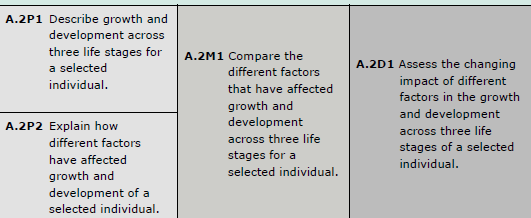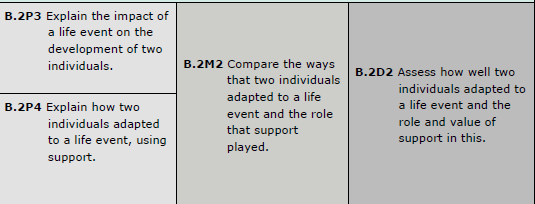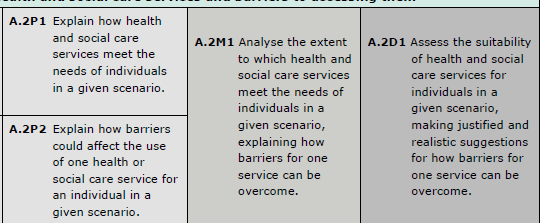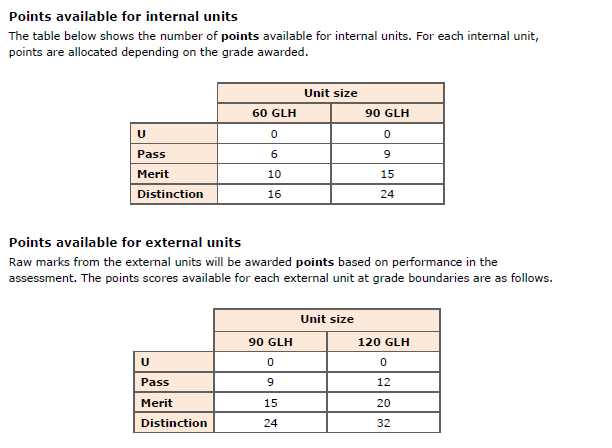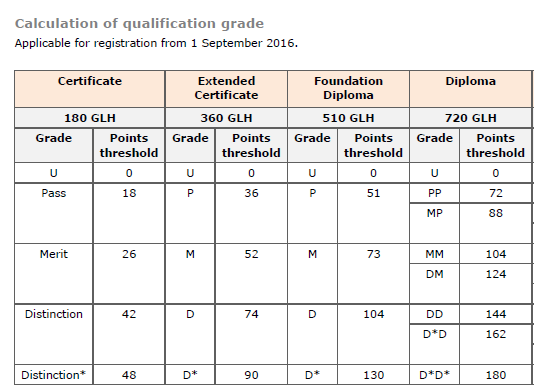Year 10
|
Curriculum Intention: Component 1: Assignment 1- Understanding how life affects our growth and Development September-December Assignment 2- Coping with Life Events January-April Intention: To cover component one (coursework) by Easter of Y10. This allows a unit of work for the Standards Verifier to request. Learners move onto component 3; section A which is a revision unit of component one and prepares the students, in part, for the external exam in Feb of Y11 and allows for quality assessment. Component 1 curriculum content: -Learners will investigate how, in real situations, human development is affected by different factors and that people deal differently with life events -how people grow and develop over the course of their life, from infancy to old age, this includes physical, intellectual, emotional and social development and the different factors that may affect them. -How an individual’s development can be affected by major life events, such as marriage, parenthood or moving house, and you will learn about how people adapt to these changes as well as the types and sources of support that can help them. -develop transferable skills, such as written communication skills, which will support your progression to Level 2 or 3 vocational or academic qualifications. Component 3: External exam Health and Wellbeing February exam 2023. Resit in May 2023 curriculum content: Spring second half term: component 3 section A This external component builds on knowledge, understanding and skills acquired and developed in Components 1 . Component 3 curriculum content: - Learners will be given a case study and will assess an individual’s health and wellbeing, drawing on their understanding of life events from Component 1.
Summer term work experience for Year 10: Providing good health and social care services is very important and a set of ‘care values’ exists to ensure this happens. Care values are important because they enable people who use health and social care services to get the care they need and to be protected from different sorts of harm. Once Summer mock exams are completed, learners start: Component 2 Health and Social Care Services and Values learning aim B Assignment title: ‘Work placement visit’ Curriculum content: - This work has the ‘demonstrate’ command verbs and so students complete a work experience placement to facilitate this. -Learners create a portfolio on work experience and begin their role play scenarios based on health and social care values |
Curriculum Implementation:
|
Autumn |
Spring |
Summer |
|
Sept 2nd - Oct 14th Introduction to Health and Social Care; careers focus. Implement: Component 1: Learning aim A: Understand human growth and development across life stages and the factors that affect it Intent: Learners will explore different aspects of growth and development across the life stages using the physical, intellectual, emotional and social (PIES) classification. Impact: Learners are asked to write a report to illustrate how people change over different life stages. They can choose an individual, such as a well-known person, and carry out desk research to find out how they have changed over the course of three life stages (the life stages chosen by learners) and then use this to write a report. Alternatively, learners can choose a family member. Immersion: Use thinking posters of images or news reports to encourage students to identify and analyse issues affected PIES over the life-stages. |
Jan 6th – March 15th Implement: Learning aim B: Investigate how individuals deal with life events
Intent: Life events are expected or unexpected events that occur in an individual’s life. Learners will explore the different events that can impact on people’s physical, intellectual, emotional and social development.
Impact: Learners are asked to contribute to a written article called Change and how people cope with it. To do this, they choose two people that have experienced the same event (e.g. marriage, redundancy, accident) and investigate how it affected them. Learners should gather evidence such as through interviewing the two people so that they can ask specific questions and draw out their experiences first-hand.
|
20th April – 18th May Implement: Revision questions of component 3: Section A
Intent: to revise the content from Component 1 and apply to case studies.
Impact: Students to practise exam questions from Section A of component 3. This knowledge will be tested in Year 10 mock exams in May.
Stretch Learning: Students begin knowledge and understanding of Care Values, in preparation for work experience visit. |
|
Half term |
Half term |
Half term |
|
Oct 28th – Dec 16th Introduction factors that affect HWB. Produce an about me presentation; who are you? Can you identify these factors in yourself? Implement: Component one Learning aim A Factors affecting growth and development
Intent: Learners will explore the different factors that can affect an individual’s growth and development. Different factors will impact on different aspects of growth and development.
Impact: students should be able to analyse each factor and decide how the individual they are writing about was impacted; either positively or negatively, by these factors. Learners should be able to assess the changing impact of different factors on their growth and development across three life stages.
Immersion: Whitney Houston and Amy Winehouse documentaries to see how factors can negatively/positively affect HWB; drug abuse, religion, family, unstable domestic relationships
|
March 15th- 30th March Introduction: Students begin Component 3 section A (towards external examination)
Implement: Demonstrate knowledge and understanding of factors that affect health and wellbeing
Intent: Factors affecting health and wellbeing- Learners will explore how factors can affect an individual’s health and wellbeing positively or negatively. This links to, and extends, knowledge and understanding of life events covered in Component 1, but here the focus is on health and wellbeing.
Impact: This external component builds on knowledge, understanding and skills acquired and developed in Components 1. Learners will be given a case study and will assess an individual’s health and wellbeing, drawing on their understanding of life events from Component 1. |
1st June – 13th July Implement: Component 2 Learning aim B: Demonstrate care values and review own practice Intent: Care values : Learners will explore and practise applying the different care values that are key to the delivery of effective health and social care services. Empowerment, Respect for the Individual, Dignity, Safeguarding, Preventing Anti-Discrimination, Confidentiality and Effective Communication.
Impact: Learners will be given the opportunity to demonstrate care values in work experience situation. Students will be placed in under 8’s provision. They then review their own performance.
Demonstrate each care value listed in their work experience packs. Then review own practice: o firstly, review how well you did o then respond to feedback received from the teacher and/or service users, making suggestions for improvement. Evidence must include signed observation records, accompanied by a checklist of the values demonstrated a written review of own performance, along with feedback received. |
|
Christmas Holidays Set Learning aim A coursework |
Easter Holidays |
Summer Holidays |
|
Outcomes: Students will produce a piece of coursework that will generate an overall grade for the component. 1. By tracking coursework completion and marking. 2. students have their own ‘mark packs’. It contains a copy of their tracking sheets of the overall components. It also contains a copy of the specification, which is signed off by staff as it is completed. Assessment feedback sheets contain guidance of how students can improve. Generic ‘coursework fixing it worksheets’ are also in the pack for extra guidance. Learning aim A
Learning aim B
|
|
|
Employability skills: This is a course that contextualises learning in real-life and/or employment scenarios. This draws naturally on the kind of broader attributes valued in the sector, for example working with others and demonstrating empathy, as well as the more general skills needed in work that fit well with project-based learning, for example teamwork and independent learning. Care Values of: Empowerment, Respect for the Individual, Dignity, Safeguarding, Preventing Anti-Discrimination, Confidentiality and Effective Communication. |
Year 11
|
Curriculum Intention: To complete Component 3: Sections B & C in preparation for external assessment in February. Curriculum content component 3: In this component, learners will look at the factors that can have a positive or negative influence on a person’s health and wellbeing. They will learn to interpret physiological and lifestyle indicators and what they mean for someone’s state of health. They will learn how to use this information to design an appropriate plan for improving someone’s health and wellbeing, including short- and long-term targets. Additionally, they will explore the difficulties an individual may face when trying to make these changes. They will develop skills in analysing information and communicating for a specific purpose, which will support progression to Level 2 or 3 vocational or academic qualifications. After February, Learners will complete gaps in learning from last academic year component 1 assignment 1 &2 March-May Component 2 Assignment 1: role play/imaginary work experience scenarios (BTEC approved) Assignment 2: Barriers to Access -Learners study and practically explore health and social care services and how they meet the needs of real service users. Students study care plans provided by the NHS and how a range of professionals are needed to meet service users needs. -Learners to complete assignment 2 based on barriers to accessing health and social care services. |
Curriculum Implementation:
|
Autumn |
Spring |
Summer |
|
Sept 2nd - Oct 14th Introduction What are physical measures of health? Implement: Interpret health indicators. Design a person-centred health and wellbeing improvement plan Intent: To teach students how to Interpret health indicators. Learners will interpret indicators that can be used to measure physiological health, interpreting data using published guidance. Impact: Learners will interpret lifestyle data in relation to risks posed to physical health.
|
Jan 6th – 10th Feb Implement: Practice questions for external exam Intent: Students have a good understanding of the exam content and how to access the higher marks. Impact : Students are prepared for component 3 external examination. Students have read question papers, answer papers and reviewed examiner reports which detail common mistakes. |
20th April – 18th May Component 2: Learning aim A: Understand the different types of health and social care services and barriers to accessing them Intent: Learners will explore the health and social care services that are available and why individuals may need to use them. Impact Learners will explore barriers that can make it difficult to use these services, and how these barriers can be overcome. Learners will be asked to carry out a review into health and social care services available in their area. Learners will be given a case study of two individuals with different health and social care needs: one will have health care needs, and the other social care needs. The case study details why they need to access these services as well as their specific circumstances which would impact on their ability to access them. Learners carry out research to find local services that meet their needs. Implement: A review of students who – in the light of the component 3 results – have not met their predicted grade. Intent: To filter these students into small revision groups and prepare for re-submission of component 3. Impact: To enable all learners to either meet or exceed their predicted grades. |
|
Half term |
Half term |
Half term |
|
Oct 28th – Dec 16th Introduction: Can you make recommendations to help someone improve their health? Implement Learners will explore the features of health and wellbeing improvement plans. · The importance of a person-centred approach that takes into account an individual’s needs, wishes and circumstances. Information to be included in plan: o recommended actions to improve health and wellbeing o short-term (less than 6 months) and long-term targets o appropriate sources of support (formal and/or informal). Intent: Students are able to write Person-centred health and wellbeing improvement plans Impact: a student understands the need to improve health. They can interpret data to write short term and long term targets, including support that will be needed. Student is able to identify obstacles and make suggestions to overcome these. |
24th Feb – 30th March Implement: Component 1: Complete the gaps in learning from last academic year component one. DS & RC classes both groups to add to their coursework in order to complete both assignments.
|
1st June – 13th July
|
|
Christmas Holidays |
Easter Holidays |
Summer Holidays |
|
Outcomes: Distinction criteria for Component 3: external examination Learners demonstrate a high level of knowledge and understanding of factors that affect health and wellbeing. They explain clearly how different factors have positive and negative impacts on health and wellbeing, including the impact of a specific life event on wellbeing. They demonstrate a high level of ability to interpret lifestyle and physiological data to explain clearly, and in detail, factors that could potentially affect an individual’s current and future physical health. Learners design a health and wellbeing improvement plan that clearly describes recommendations, with specific and realistic short- and long-term targets and sources of support that are linked to the targets. They provide a clear and convincing justification for the plan in terms of how it links to needs, wishes and circumstances of the individual. They clearly describe potential obstacles that might arise in keeping to the plan and make realistic suggestions for how these may be overcome. Outcome for Component 2: Learning aim A
How will you know students are making progress? 1. By tracking coursework completion and marking. 2. students have their own ‘mark packs’. It contains a copy of their tracking sheets of the overall components. It also contains a copy of the specification, which is signed off by staff as it is completed. Assessment feedback sheets contain guidance of how students can improve. Generic ‘coursework fixing it worksheets’ are also in the pack for extra guidance. |
|
|
Employability skills: The examination unit encourages analysis and assessment of health data and statistics. |
Year 12
|
Curriculum Intention: Extended Certificate Y1 – units 1 & 5. This allows students to ‘cash in’ and leave with Certificate, if required. Unit 1 is 90 Credits National Diploma Y1 – Unit 8 & 7. Knowledge and understanding of these units are required in the synoptic external exam in Year 2. Unit 7 allows for work experience hours to be completed. This gives students the opportunity to select Unit 6 Work Experience in Y2. Unit 2 Working in Health and Social Care is an externally assessed unit, to be taken Jan in Year 2. However, as it is worth 120 credits, study in started in Y1. |
Curriculum Implementation:
|
Autumn |
Spring |
Summer |
|
Sept - Oct 14th Extended Certificate: Unit 1 Human Lifespan & Development learning aim A Human growth and development through the life stages (RC) Learning aim B: Factors affecting human growth and development (DS) Diploma students: as above but additionally Unit 8 Public Health Learning aim A & B (RC only)
A Examine strategies for developing public health policy to improve the health of individuals and the population B Examine the factors affecting health and the impact of addressing these factors to improve public health
|
Jan 6th – 10th Feb Unit 5 External Examination TBC early January Extended Certificate: Unit 5 Meeting Individual Care and Support Needs (internally assessed unit) Learning aim A Examine principles, values and skills which underpin meeting the care and support needs of individuals (RC) Learning aim B Examine the ethical issues involved when providing care and support to meet individual needs (DS) Diploma Students: as above but additionally Unit 7 Health, Safety and Security in Health and Social Care (RC only) Learning aim A: Examine how a duty of care contributes to safe practice in health and social care Settings STUDENTS TO FIND WORK EXPERIENCE PLACEMENT |
20th April – 18th May
Extended Certificate: Unit 2 Working in Health and Social Care (externally assessed unit)
Learning aim A The roles and responsibilities of people who work in the health and social care sector (RC & DS)
Diploma Students: as above but additionally Unit 7 Health, Safety and Security in Health and Social Care (RC only)
Learning aim C: Investigate the influence of health and safety legislation and policies in health and social care settings
|
|
Half term |
Half term |
Half term |
|
Oct 28th – Dec Extended Certificate: Unit 1 Human Lifespan & Development learning aim C Human growth and development through the life stages (RC) Mock exam practice (DS & RC) Diploma students: as above but additionally Unit 8 Public Health Learning aim C &D (RC only) C Investigate how health is promoted to improve the health of the population D Investigate how health promotion encourages individuals to change their behaviour in relation to their own health.
|
24th Feb – March half term Extended Certificate: Unit 5 Meeting Individual Care and Support Needs (internally assessed unit) Learning aim C: Investigate the principles behind enabling individuals with care and support needs (DS) to overcome challenges Learning aim D: Investigate the roles of professionals and how they work together to provide the care and support necessary to meet individual needs. (RC) Diploma Students: as above but additionally Unit 7 Health, Safety and Security in Health and Social Care (RC only) Learning aim B: Understand how to recognise and respond to concerns about abuse and neglect in health and social care settings (students to use work-placement for setting information) |
1st June – end of term
Extended Certificate: Unit 2 Working in Health and Social Care (externally assessed unit)
Learning aim A contd: Specific responsibilities of people who work in health and social care settings: Applying care values and principles and ensuring safety. Diploma Students: as above but additionally Unit 7 Health, Safety and Security in Health and Social Care (RC only) Learning aim D: Explore procedures and responsibilities to maintain health and safety and respond to accidents and emergencies in health and social care settings |
|
Christmas Holidays |
Easter Holidays |
Summer Holidays |
|
Outcomes: Students progress is tracked against a point system.
Students are to take first submission of external examinations in January. This allows for a re-submission, if necessary the following May. Employability Contd: Unit 2 A1 The roles of people who work in health and social care settings Understand the roles of people who work in health and social care settings, to include: • doctors • nurses • midwives • healthcare assistants • social workers • occupational therapists • youth workers • care managers/assistants • support workers. Unit 7 Learners have knowledge and understanding, as well as application to health and social care setting of: Duty of care, recognising and responding to signs of abuse and neglect, Policies and Procedures that influence health and safety; as well as responding to accidents and emergencies. |
|
|
Employability skills: In the BTEC National units there are opportunities during the teaching and learning phase to give learners practice in developing employability skills. Where employability skills are referred to in this specification, we are generally referring to skills in the following three main categories: • cognitive and problem-solving skills: use critical thinking, approach non-routine problems applying expert and creative solutions, use systems and technology • intrapersonal skills: communicating, working collaboratively, negotiating and influencing, self-presentation • interpersonal skills: self-management, adaptability and resilience, self-monitoring and development. There are also specific requirements in some units for assessment of these skills where relevant. For example, where learners are required to undertake real or simulated activities. |
Year 13
|
Curriculum Intention: Extended Certificate – External Examination January. Allows re-sit, if necessary, May. Complete last unit of coursework after January. National Diploma – Unit 4 release materials available November, for external exam in January. As above, allows re-sit in May if necessary. (There are no Diploma students for 2021/22) Complete last unit of 19 after January. |
Curriculum Implementation:
|
Autumn |
Spring |
Summer |
|
Sept 2nd - Oct 14th Extended Certificate What will be studied? Completing study of Unit 2. Why? In preparation for external exam in January. |
Jan 6th – 10th Feb What? Unit 14 – final unit of coursework. Disease 1 – Learning aim A, B & C Why? Final unit of coursework.
|
20th April – 18th May Students finalise coursework in preparation for Standards Verification process.
Prepare for any re-sit of exam necessary. |
|
Half term |
Half term |
Half term |
|
Oct 28th – Dec 16th What will be studied? Complete unit 2. Exam skills. Why? In preparation for external exam in January. |
24th Feb – 30th March What? Unit 14 – final unit of coursework. Disease 2 – Learning aim A, B & C. Learners decided which disease to write base Learning aim D on. Why? Final unit of coursework. |
1st June – 13th July
|
|
Christmas Holidays |
Easter Holidays |
Summer Holidays |
|
Outcomes: Correct analysis and tracking of students will enable staff to see learner progress. Tracking will be based on previous year ( 180 credits out of 320 available). Unit 2 results will give a further 120 credits.
|
|
|
Employability skills: Year 13’s consider careers choices and UCAS applications. |



